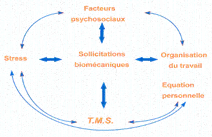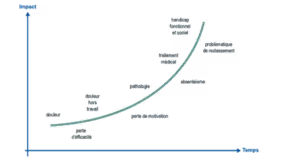MSDs? What is it?
According to Public Health France, Musculoskeletal Disorders (MSDs) define a set of Disorders of the musculoskeletal system manifesting in daily pain and discomfort.1
MSDs mainly affect structures located Close to the Joints, in particular, tendons, muscles, nerves, nerves, ligaments and vessels. The preferred areas for these disorders are located in the upper part of our body (shoulder, elbow, back, hand) but they can just as well affect the lower part of the body (the knee or the foot for example).
Thus, the pathologies most frequently observed when talking about MSDs are: low back pain, neck pain, carpal tunnel syndrome or even shoulder rotator cuff syndrome.
Who is affected by MSDs?
According to Health Insurance, MSDs represent more than 87% of occupational diseases Having resulted in a work stoppage or financial compensation due to after-effects2. They thus constitute the 1st cause of occupational disease And no sector is spared.
Musculoskeletal disorders affect a person's health and quality of life. They represent an economic and societal burden that will continue to increase in the coming years. Indeed, in the context of the aging of the population and the increase in life expectancy will irretrievably lead to this increase in MSDs.
TMS therefore extends to almost all professions and all sectors.
How do they come about?
TMS are the result of Imbalance between the body's physical abilities On the one hand And the solicitations On the other hand. The onset of MSDs is sometimes very rapid, however, it is more common to see them appear frequently.
Several factors are involved in the onset of MSDs.
- Individual factors
Some of these factors cannot be modified, such as age, gender or even family predisposition. Others can be achieved through preventive interventions, such as tobacco use and physical inactivity.
- Mechanical and biomechanical factors
Heavy lifting or restrictive postures can lead to the appearance of MSDs. The more stress you put on, the higher the risk of acute injuries or chronic wear and tear. When these postures and load carrying are carried out repeatedly, the constraints are more regular, and all the more increase the risk of developing MSDs.
- Tea Environmental Factors
The lack of lighting, cold and noise are environmental factors that worsen mechanical stress.
- Psychosocial factors
Monotonous work, stress, poor social relationships or lack of recognition are among the psychosocial factors that considerably increase the risk of developing MSDs.
- Factors related to the organization of work
Too short deadlines, the lack of breaks and resources as well as a steady pace are also factors in the occurrence of TMS.

The onset of musculoskeletal disorders is therefore multifactorial, but can be divided into two categories: occupational risk factors and individual risk factors.
What are the consequences of MSDs?
It depends on the intensity phase of the TMS:
- During the So-called “initial” phase, the symptoms occur during the tasks performed. Elles Appear Over the Course of the Day or Week But disappear in the evening. At this point, they Do Not Impact Work Of the employee, nor his quality of life.
- During the Middle Phase, the breads Appear earlier in the day or earlier in the week. They Start to Feel Each Other Outside of Work and Impact the Employee's Capacity to Work Little by Little.
- The phase of Proven pathology, where The pathology is recognized and impacts the employee. The pain is chronic and enduring during activities as well as at rest.

In summary, people affected by MSDs experience a real loss of mobility and independence. This situation almost systematically leads to a Achieving Quality of Life, and therefore generates, direct or indirect socio-economic costs.
If we place ourselves in a company strategy, we automatically deduce an impact on the employee (pain, fatigue, disability, work stoppage...) but also on the company (absenteeism, decrease in productivity, increase in contributions, increase in contributions, increase in contributions, increase in contributions, increase in contributions, recruitment problems, recruitment problems, increase in contributions, increase in contributions, recruitment problems, increase in contributions, recruitment problems, recruitment problems...).
It is a global impact, which is felt both on the health system, but also on the economic level, pushing us to look not only for preventive measures but also for effective and sustainable solutions over time.
Are there solutions against MSDs?
On the professional level, of course, Prevention remains THE solution to avoid the appearance of these MSDs.
Solutions Organizational Can Make It Possible to Diversify Tasks or to Set Up rotations to avoid repetitiveness. Another plug, The Organization of Working Time With break planning, which gives employees the opportunity to rest, is proving to be an effective solution to avoid the occurrence of MSDs.
Les Training, Gestures and Postures Are also key components in this first approach. Adopting the right postures at work is an effective solution to prevent the occurrence of MSDs. It is useful to remind employees of the importance of these actions, which are both simple and so effective for their health. For example, it is estimated that carrying a load without bending the knees multiplies the force exerted on the vertebrae by 5.
Of Technical solutions May be considered: the Layout of Workstations or the choice of new equipment to facilitate the work of operators, prove to be solutions to reduce physical stresses and facilitate the work of operators.
Finally, there are also other solutions such as Exoskeletons gold The Manipulative Arms Which not only reduces the risk of MSDs, but also leads to the improvement of the quality of life of employees.
1 Musculoskeletal Disorders [Internet]. [January 12, 2021] Available at: https://www.santepubliquefrance.fr/maladies-et-traumatismes/maladies-liees-au-travail/troubles-musculo-squelettiques
2 Understanding musculoskeletal disorders [Internet]. [cited August 22, 2021]. Available on: https://www.ameli.fr/assure/sante/themes/tms/comprendre-troubles-musculosquelettiques


